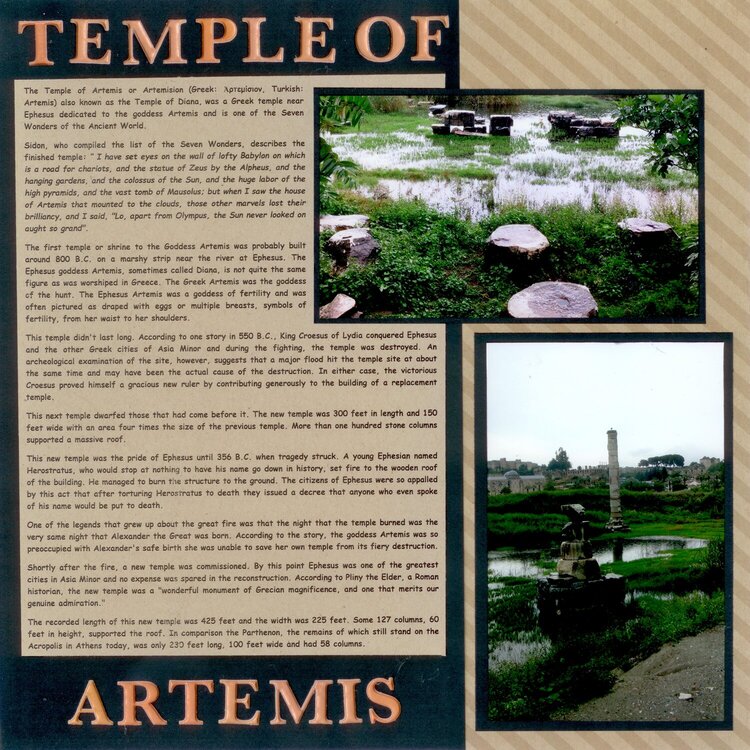

 Give a Cheer
Give a Cheer
The Temple of Artemis or Artemision (Greek: Ἀρτεμίσιον, Turkish: Artemis) also known as the Temple of Diana, was a Greek temple near Ephesus dedicated to the goddess Artemis and is one of the Seven Wonders of the Ancient World.
Sidon, who compiled the list of the Seven Wonders, describes the finished temple: “ I have set eyes on the wall of lofty Babylon on which is a road for chariots, and the statue of Zeus by the Alpheus, and the hanging gardens, and the colossus of the Sun, and the huge labor of the high pyramids, and the vast tomb of Mausolus; but when I saw the house of Artemis that mounted to the clouds, those other marvels lost their brilliancy, and I said, "Lo, apart from Olympus, the Sun never looked on aught so grand".
The first temple or shrine to the Goddess Artemis was probably built around 800 B.C. on a marshy strip near the river at Ephesus. The Ephesus goddess Artemis, sometimes called Diana, is not quite the same figure as was worshiped in Greece. The Greek Artemis was the goddess of the hunt. The Ephesus Artemis was a goddess of fertility and was often pictured as draped with eggs or multiple breasts, symbols of fertility, from her waist to her shoulders.
This temple didn't last long. According to one story in 550 B.C., King Croesus of Lydia conquered Ephesus and the other Greek cities of Asia Minor and during the fighting, the temple was destroyed. An archeological examination of the site, however, suggests that a major flood hit the temple site at about the same time and may have been the actual cause of the destruction. In either case, the victorious Croesus proved himself a gracious new ruler by contributing generously to the building of a replacement temple.
This next temple dwarfed those that had come before it. The new temple was 300 feet in length and 150 feet wide with an area four times the size of the previous temple. More than one hundred stone columns supported a massive roof.
This new temple was the pride of Ephesus until 356 B.C. when tragedy struck. A young Ephesian named Herostratus, who would stop at nothing to have his name go down in history, set fire to the wooden roof of the building. He managed to burn the structure to the ground. The citizens of Ephesus were so appalled by this act that after torturing Herostratus to death they issued a decree that anyone who even spoke of his name would be put to death.
One of the legends that grew up about the great fire was that the night that the temple burned was the very same night that Alexander the Great was born. According to the story, the goddess Artemis was so preoccupied with Alexander's safe birth she was unable to save her own temple from its fiery destruction.
Shortly after the fire, a new temple was commissioned. By this point Ephesus was one of the greatest cities in Asia Minor and no expense was spared in the reconstruction. According to Pliny the Elder, a Roman historian, the new temple was a "wonderful monument of Grecian magnificence, and one that merits our genuine admiration."
The recorded length of this new temple was 425 feet and the width was 225 feet. Some 127 columns, 60 feet in height, supported the roof. In comparison the Parthenon, the remains of which still stand on the Acropolis in Athens today, was only 230 feet long, 100 feet wide and had 58 columns.
No products have been added to this project.
Thanks for spreading positivity!
December 16, 2014
December 15, 2014
December 13, 2014
December 07, 2014
December 05, 2014
December 04, 2014
December 04, 2014
December 03, 2014
December 03, 2014
December 03, 2014
December 02, 2014
December 02, 2014
December 02, 2014
December 02, 2014
December 02, 2014
December 01, 2014
December 01, 2014
December 01, 2014
December 01, 2014